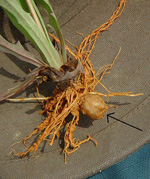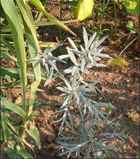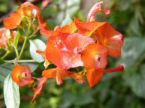Tea Remedies Decoctions |
When the herbs to be used are hard such as, roots, seeds, barks, stems and particularly thick or tough leaves, it is better to make a decoction as the cell walls are very strong and they required a stronger method to extract the active constituents. Most of the proportions are the same as for the infusion (1 teaspoon to 1 cup) but the herb is placed in a glass, enamel or stainless steel pan, covered with the cold water and brought to a boil. Keeping the pan tightly covered allow it to simmer for 5 to 15 min then strain off and drink. You can use a decoction and infusions in the same way, and dosages are usually the same. If you are making a mixture of soft and hard herbs, make a decoction of the hard herbs first, then use the decoction to pour over the soft part to make an infusion. |
Cascara Sagrada (Rhamnus Purshiana):The bark is used as a stimulant laxative, especially in cases of chronic constipation. The name "sagrada" refers to "sacred bark"—a name given to it by early Spanish explorers in the Pacific Northwest. As an approved, safe and effective laxative, cascara and cascara extracts are found in numerous over-the counter laxative preparations in the U.S. |
 |
Chamomile (German) (Matricaria Recutita): Used internally, chamomile flowers are antispasmodic and used to relieve digextive upset. A popular remedy for indigestion, flatulence, gastrointestinal spasms, and inflammation of the gastrointestinal tract. Often used as a bedtime beverage, its mild sedative effects have not been adequately scientifically proven. Externally, chamomile extracts are useful for inflammation of skin and mucous membranes. |
Cranberry (Vaccinium Macrocarpon):Recent research suggests that cranberry helps to prevent urinary tract infections caused by E. coli bacteria, particularly in people with a history of recurrent infections. Cranberry is an excellent example of how common foods can have health benefits beyond their nutritional qualities. |
 |
Dandelion (Taraxacum Officinale): The young leaves are widely used as salad greens and in tea as a natural diuretic. The roots are a mild laxative and promote bile flow and liver function. |
Goldenseal (Hydrastis Canadensis): Goldenseal root has a long history as a native American herb used by Indians and early settlers for its antiseptic wound-healing properties. It is also used for its soothing action on inflamed mucous membranes. A popular remedy for colds and flu. Peppermint (Men Tha Piperita): Internally, peppermint has an antispasmodic action, with a calming effect on the stomach and intestinal tract. As a tea, extract, or in a capsule, peppermint is useful for indigestion, cramp-like discomfort of the upper gastrointestinal and bile duct, irritable bowel syndrome and inflammation or irritation of the gums. |
 |
Alhucema (Lavender): New Mexicans have relied on Alhusema for years for its used in botanical herb remedies. This herb was first introduced and used by early Spanish settlers. Traditionally, it is used as a mild stomach tonic for colic in infants, but it is also a reliable aid in adult stomach disorders. Alhusema does have a sedative effect that makes it an excellent calmative for migraine headaches, nervousness and makes a relaxing bedtime tea. For phlegm in small babies, a tea of the boiled seeds is either drunk by the nursing mother or rubbed on her nipples prior to a feeding. For congestion in older children, dipping a cloth in the hot tea and placing it on the chest of the child makes a fomentation. This process is repeated until the liquid cools. Because of its versatility, Alhusema is a well-trusted and widely used herb in New Mexico. |
Altamisa (Mt. Mugwort): Grandmothers and grandfathers all over New Mexico will swear by Altamisa's powers to cure bad winter colds and coughs. Altamisa is often referred to as a "fever-few" because it is so well known and widely used to relieve the unwanted maladies that are associated with high fevers and flu. A decotion of the boiled flowers relieves indigestion and upset stomach and will also induce a sweat, which will aid in drawing out highfevers. Amolillo (Licorice): Because of its pleasantely sweet taste, Amolillo is a good addition to any bad tasting herbal tea. To soothe a sore, dry throat accompanied with congestion, 2 tablespoons of the chopped root, 1 small onion and 1/2 cup of corn syrup are boiled in 1 cup of water for a sweet syrup remedy. A tea of Amolillo and Manzanilla acts as a calming, gentle laxative for children with stomachaches. Canutillo (Mormon Tea): Canutillo contains some excellent medicinal properties that are useful in a number of different remedies such as urinary tract cleansing, alleviation of kidney problems or as an aid for infections. The jointed stems of Canutillo are boiled into an infusion that is drunk cold. To improve facial complexion, the same infusion is used as a daily wash. During the seasons when allergies are present, a cup (warm or cold) of Canutillo should be drunk regularly, taking advantage of the herb's excellent decongestant properties. According to legend, the people of the Old Southwest believed this herb to be a safeguard against venereal diseases. Contra Yerba (Arizona Poppy): This popular herb is used mainly for sore throats. A tea of powdered Contra Yerba will aid in diarrhea and indigestion. The same tea serves as a mouthwash for inflamed gums and as as a disinfectant wash for external wounds. |
 |
Estafiate (Fringed Sage): A bitter tea made with this pretty sage is considered to be an excellent stomach tonic. For sore throats the tea should be gargled every hour until the pain subsides. Indians recommend the herbal remedy for colds and flu. |
| Manstranso (Horehound or Applemint): This mint herb was widely used by early Spanish settlers to treat colds and flu. A tea of Manstranso is drunk to induce a mild sweat, and is also used as a cooling fever bath. Syrup made with honey, sugar, and Manstranso is recommended for coughs. A hot tea of Manstranso is considered an excellent stomach bitter. |

